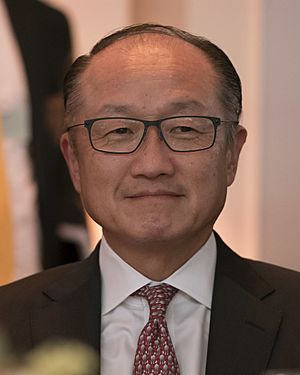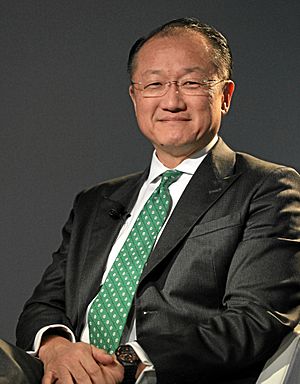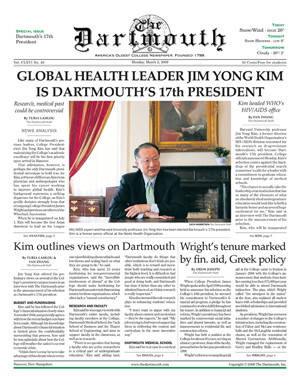Jim Yong Kim facts for kids
Quick facts for kids
Jim Yong Kim
김용 |
|
|---|---|

Kim in 2018
|
|
| 12th President of the World Bank Group | |
| In office July 1, 2012 – February 1, 2019 |
|
| Chief Executive | Kristalina Georgieva |
| Preceded by | Robert Zoellick |
| Succeeded by | Kristalina Georgieva (Acting) |
| 17th President of Dartmouth College | |
| In office July 1, 2009 – June 30, 2012 |
|
| Preceded by | James Wright |
| Succeeded by | Philip J. Hanlon |
| Personal details | |
| Born | December 8, 1959 Seoul, South Korea |
| Political party | Democratic |
| Spouse | Younsook Lim |
| Children | 2 |
| Education | University of Iowa Brown University (BS) Harvard University (MD, PhD) |
| Jim Yong Kim | |
| Hangul |
김용
|
|---|---|
| Hanja | |
| Revised Romanization | Gim Yong |
| McCune–Reischauer | Kim Yong |

Jim Yong Kim (Korean: 김용; born December 8, 1959), also known as Kim Yong, is an American doctor and expert in human cultures. He was the president of the World Bank from 2012 to 2019.
Before that, he was a leader in global health, helping people around the world stay healthy. He was a professor at Harvard Medical School and helped start an organization called Partners In Health. He also served as the president of Dartmouth College from 2009 to 2012. He was the first Asian American to lead an Ivy League university.
In 2013, Forbes Magazine named Jim Yong Kim one of the world's most powerful people.
Early Life and Education
Jim Yong Kim was born in Seoul, South Korea, in 1959. When he was five years old, his family moved to the United States. He grew up in Muscatine, Iowa. His father taught dentistry at the University of Iowa, and his mother earned a PhD in philosophy.
Kim went to Muscatine High School. He was the top student in his class and also the class president. He played quarterback on the football team and point guard on the basketball team. After attending the University of Iowa for a year and a half, he transferred to Brown University. He graduated from Brown in 1982 with a degree in human biology. Later, he earned his medical degree (M.D.) from Harvard Medical School in 1991. He also received a PhD in anthropology from Harvard University in 1993.
Career Highlights
Helping People with Partners In Health (1987–2003)
In 1987, Jim Yong Kim helped start an organization called Partners In Health (PIH). He co-founded it with Paul Farmer and others. This group focused on providing healthcare in poor communities, starting in Haiti. They trained local people to help deliver care.
By the early 1990s, their program in Haiti was helping over 100,000 people. They found ways to treat serious diseases like tuberculosis at a very low cost. For example, curing a tuberculosis patient at home cost much less than in a U.S. hospital. Kim played a key role in creating these treatment plans and getting cheaper medicines.
In 1994, PIH expanded its work to Peru. Their success in treating common and serious illnesses led the World Health Organization (WHO) to adopt their methods. In 2002, the WHO even used PIH's approach to treat a difficult type of tuberculosis called multi-drug-resistant tuberculosis (MDR-TB). Kim's work with PIH was the first large-scale effort to treat MDR-TB in a poor country. This approach has since been used in more than 40 countries.
PIH now has over 18,000 employees in 11 countries. Jim Yong Kim left the organization in 2003. His work with Partners in Health is shown in the 2017 film Bending the Arc.
Leading at the World Health Organization (2003–2006)
In 2003, Kim joined the World Health Organization (WHO). In 2004, he became the director of WHO's HIV/AIDS department. He oversaw all of WHO's efforts to fight HIV/AIDS, especially in developing countries.
He focused on helping these countries improve their treatment and prevention programs. One big goal was the "3x5 initiative," which aimed to get three million people in developing countries on AIDS treatment by the end of 2005. While the goal was reached in 2007, it greatly sped up AIDS treatment in Africa. By 2012, this program had treated over 7 million Africans with HIV.
Teaching and Research at Harvard (1993–2009)
From 1993, Kim taught at Harvard Medical School. He became a professor of medicine, social medicine, and human rights. Before leaving in 2009, he was the head of the Department of Global Health and Social Medicine. He also led the Division of Global Health Equity at Brigham and Women's Hospital.
During his time at Harvard, Kim wrote many articles for important scientific journals. He was an expert on tuberculosis and served on several committees about international TB policy.
President of Dartmouth College (2009–2012)
In March 2009, Jim Yong Kim became the 17th president of Dartmouth College. He was the first Asian-American president of an Ivy League school. He started several new programs at Dartmouth, using his experience in health and international affairs.
For example, in 2010, he helped Dartmouth students and staff work with Partners In Health to respond to the terrible 2010 Haiti earthquake. This effort, called the Dartmouth Haiti Response, raised over $1 million and sent medical supplies and volunteers to Haiti.
He also launched the National College Health Improvement Project (NCHIP) to improve student health. In 2010, he helped get a $35 million grant to create the Dartmouth Center for Health Care Delivery Science. This center helps researchers and doctors work together to find ways to provide high-quality, affordable healthcare.
Challenges During His Time at Dartmouth
During his time at Dartmouth, Kim faced some challenges. In 2011, some faculty members wanted more details about the college's budget. He responded by sharing a detailed report and holding a public meeting. There were also some criticisms from students and a newspaper about his leadership.
Leading the World Bank (2012–2019)

On March 23, 2012, U.S. President Barack Obama announced that he was choosing Jim Yong Kim to be the next president of the World Bank. Kim said that the World Bank is "one of the most critical institutions fighting poverty and providing assistance to developing countries in the world today."
On April 16, 2012, the World Bank officially elected Kim as its president. He was the first leader of the Bank who did not come from a political or financial background. He was also the first to have direct experience helping people with health issues in developing countries.
When he started, Kim said the World Bank would work to support growth, use solutions based on facts, and listen more to developing countries. He was reappointed for a second term in 2016. However, on January 7, 2019, Kim announced he would step down from his role on February 1, 2019. He later joined a company called Global Infrastructure Partners.
In 2021, an investigation found that some World Bank leaders, including Kim, had asked staff to change data. This was done to make some countries, like China and Saudi Arabia, appear to have better rankings than they actually did.
Personal Life
Jim Yong Kim is married to Younsook Lim, who is a pediatrician (a doctor for children). They have two children.
Kim enjoys various sports, including basketball, volleyball, tennis, and golf. He learned to speak Korean when he was 24, after moving to Korea for his studies. He also speaks Spanish.
Awards and Recognition
Jim Yong Kim has received many honors for his work. In 2003, he received a MacArthur Fellowship, which is a special award for talented individuals. In 2005, U.S. News & World Report named him one of America's 25 Best Leaders. In 2006, Time Magazine listed him as one of the 100 most influential people in the world.
He is also a member of the Institute of Medicine of the United States National Academies. In 2010, he was elected to the American Academy of Arts and Sciences.
See also
 In Spanish: Jim Yong Kim para niños
In Spanish: Jim Yong Kim para niños


